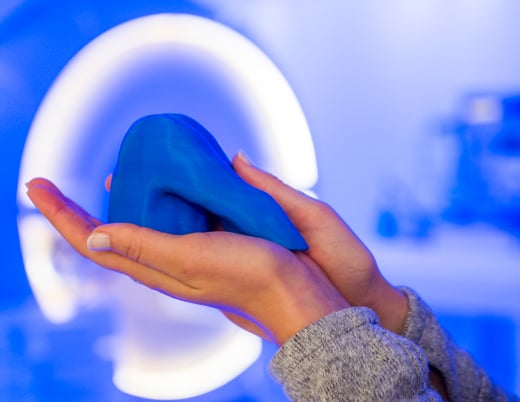Key takeaways
-
A healthy pregnant woman presented to our hospital with a 19-week-old fetus in complete heart block (CHB). Although she had no symptoms of Sjogren’s syndrome, the mother had anti-Ro/SSA antibodies, which are causative in fetal congenital heart defect.
-
The CHB could not be reversed, and despite medical treatment, the fetus developed heart failure and extreme bradycardia (fetal heart rate 44 beats per minute). The mother underwent a successful EXIT (ex utero intrapartum treatment) delivery to ventricular pacing when the fetus was 36 weeks old.
-
This surgical approach may provide more options for fetuses with CHB due to maternal anti-Ro/SSA antibodies that are at risk to die in utero or that are too premature for immediate delivery.
Case background: complete heart block can cause fetal death
A fetus whose mother has anti-Ro/SSA antibodies has a 4% risk of developing complete heart block (CHB). The risk of perinatal death, even if paced in the first day of life, is six- to 11-fold higher if the fetus:
- Develops CHB at <20 weeks of gestation
- Has heart rate (FHR) <50 beats per minute (bpm)
- Develops heart failure
Case report: ex utero intrapartum treatment to ventricular placement pacing on fetus with CHB
The 19-week-old fetus of a healthy 21-year-old presented to her obstetrical provider with FHR of 60 bpm. The low FHR was diagnosed as CHB. Two days prior to the visit, the FHR had been normal.
Although she was asymptomatic and had no history of connective tissue disease, such as systemic lupus erythematosus or Sjogren’s syndrome, the mother was found to have very high anti-Ro/SSA antibodies, which are known to cause fetal CHB.
In an unsuccessful attempt to reverse the CHB, the mother received a dose of IV immune globulin and dexamethasone. At 26 weeks, terbutaline was prescribed to increase the FHR, which had fallen to <55 bpm. Despite treatment, at 36 weeks the FHR fell to 47 bpm and profound heart failure developed.
Experts from the Colorado Fetal Care Center at Children’s Hospital Colorado held a multidisciplinary meeting that included experts from neonatology, fetal surgery, cardiothoracic surgery, anaesthesia, fetal cardiology and electrophysiology. The team agreed that an EXIT (ex utero intrapartum treatment) delivery to ventricular pacing would be the only way to save the fetus.
The EXIT procedure allows lifesaving fetal/neonatal interventions while maintaining the uteroplacental circulation. The goal of the EXIT procedure is to provide a successful transition to extra-uterine life.
Procedure: performing EXIT and ventricular pacing for delivery
Henry Galan, MD, co-director of the Colorado Fetal Care Center, performed the EXIT procedure. Bettina Cuneo, MD, former Director of Fetal Cardiology, monitored FHR and cardiac function. While the infant was on placental bypass, Max Mitchell, MD, pediatric cardiothoracic surgeon, placed temporary epicardial ventricular pacing leads, and Johannes von Alvensleben, MD, pediatric electrophysiologist paced the heart. The infant was then delivered and successfully transitioned to postnatal life.
Here are additional procedure details:
- Mother and fetus were anesthetized with epidural, inhalational and total IV anesthesia
- Fetal head, chest and upper extremities delivered through low traverse uterine incision
- The fetus received an infusion of isoproterenol and epinephrine prior to pacemaker insertion
- The fetus was paced at 70 bpm 10 minutes after the pacemaker incision was made
- The fetus was delivered 55 minutes after the EXIT
At 3 days old, we placed permanent epicardial left atrial and left ventricular pacing leads. We extubated the baby on the second postoperative day and discharged the baby from cardiac intensive care at 7 days old.
Case conclusion: EXIT treatment an option for some life-threatening circumstances
The role of EXIT in temporary ventricular pacing for the fetus with CHB must be further defined and patients must be selected carefully. This "rescue" pacing may provide an option for the most fragile patients with CAVB: fetuses at high risk for in utero demise, but too premature for delivery and too small for ECMO.
Collaboration means better care and outcomes
As part of a comprehensive, multidisciplinary approach, the Colorado Fetal Care Center works collaboratively with the renowned fetal cardiology specialists at the Heart Institute at Children’s Colorado. This partnership ensures top outcomes for fetal cardiac patients and allows for a lifelong continuum of care.
Refer a patient
The Colorado Fetal Care Center offers comprehensive fetal and maternal care for women facing complex or high-risk pregnancies.
Featured Researchers

Henry Galan, MD
Maternal Fetal Medicine Specialist
Colorado Fetal Care Center
Children's Hospital Colorado
Professor
OB-GYN-Maternal Fetal Medicine
University of Colorado School of Medicine

Johannes von Alvensleben, MD
Director, Pediatric and Adult Electrophysiology Program
The Heart Institute
Children's Hospital Colorado
Associate professor
Pediatrics-Cardiology
University of Colorado School of Medicine





 720-777-0123
720-777-0123










